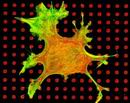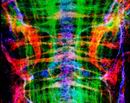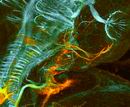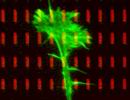
KIT (Karlsruher Institut für Technologie) Zoologisches Institut Abteilung für Zell- und Neurobiologie |
 |
 |
 |
| Homepage |
| Mitarbeiter |
| Lehre |
| Forschung |
| Ausgewählte Publikationen |
| Diplomarbeiten, Zulassungsarbeiten, Doktorarbeiten |
| Anfahrt, Lageplan |
| » Zur AG Franz |
| » Zur Fakultät |
| » Zum CFN |
| » Zur KSOP |
» Zum KIT 
|
| Normal and pathalogical wiring in the mouse forebrain | |
|
Zurück zur Übersicht "Forschung" Scientists involved: Philipp Kaiser, Dr. Franco Weth Funding: Karlsruhe School of Optics and Photonics (KSOP) Differentiation and guidance in higher order brain structures is thought to require complex combinations of guidance mechanisms. As a model, we investigate the potential involvement of classical guidance signals in the development of the thalamocortical system, which is a central substrate of information processing in the mammalian forebrain. Deviations of normal neurodevelopment are believed to underlie severe mental disorders. As an example, we analyze the molecular consequences of neuregulin-1 hypomorphism in the mouse, which is used as a genetically validated model of schizophrenia.
Scientists involved: Dr. Franco Weth To further address the complexity of guidance in higher order brain structures, we have started a comprehensive in situ hybridization survey of the expression of the complete ephrin / Eph and semaphorin / plexin / neuropilin systems at various stages of embryonic and postnatal development of the mouse thalamocortical system. By this approach, based on expression patterns, we seek to identify candidate genes that might be involved in processes like radial migration of excitatory neuron precursors, tangential migration of precursors of GABAergic interneurons, thalamocortical and corticothalamic pathfinding. Candidates will subsequently be scrutinized in functional assays. Collaboration partners: Dr. Geraldine Zimmer, Prof. Dr. J. Bolz (both University of Jena) and Dr. Ronny Niehage (former collaborator). 
Expression of ephrin Eph genes in the mouse thalamus on embryonic day 14. Scientists involved: Philipp Kaiser, Dr. Franco Weth Failures of neurodevelopment are supposed to underlie severe mental disorders like schizophrenia. We therefore try to translate our expertise on brain development to the investigation of the pathogenic mechanisms of this disease. Schizophrenia is a devastating neurodevelopmental disorder, which manifests itself mostly during early adulthood. It is characterized by symptoms like delusions, hallucinations, emotional flattening and social withdrawal. Genetic factors contribute strongly to the pathogenesis of schizophrenia and neuregulin-1 is one of the most promising susceptibility genes. Its actual molecular mechanism, however, remains largely elusive. We are therefore performing a detailed transcriptomic analysis using photolithographically fabricated microarrays (Affymetrix) to elucidate the molecular consequences of neuregulin-1 hypomophism in the mouse brain. Candidate genes are validated by in situ hybridization and quantitative PCR (realtime fluorescence spectrometry). Collaboration partners: Prof. Dr. Carmen Birchmeier (Max-Delbrück-Zentrum, Berlin-Buch), Mehmet Sohmel (CAS-MPG Partner Institute for Computational Biology, Shanghai).  | |
|---|---|